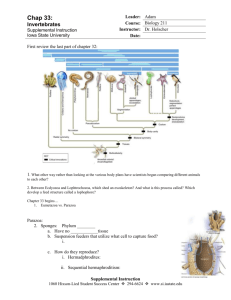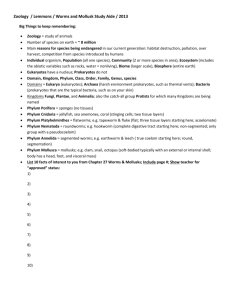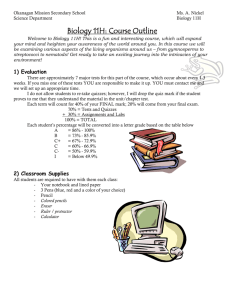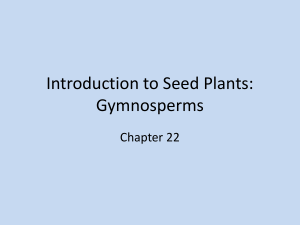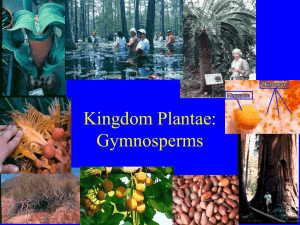Understanding Our Environment
advertisement
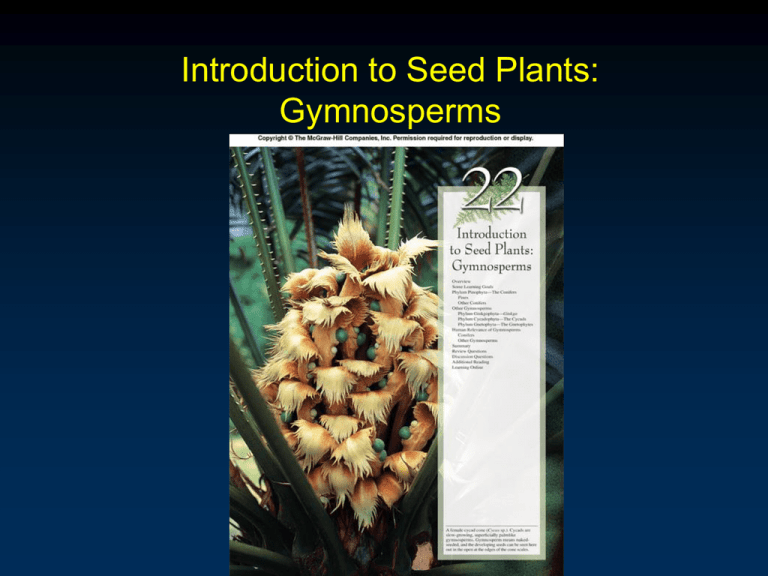
Introduction to Seed Plants: Gymnosperms Outline • • • • • • Overview Phylum Pinophyta Phylum Ginkgophyta Phylum Cycadophyta Phylum Gnetophyta Human Relevance of Gymnosperms Conifers Other Gymnosperms Overview • Gymnosperm refers to the exposed nature of the seeds. Produced on the surface of sporophylls or similar structures instead of being enclosed within a fruit as in flowering plants. - Female gametophyte is produced inside an ovule that contains a nucellus. Enclosed in integument. Four living Phyla The Plant Ovule Exposed versus Enclosed Seeds Phylum Pinophyta • The Conifers Pines - Largest genus of conifers. Over 100 living species. Include world’s oldest known living organisms (Bristlecone Pines). Phylum Pinophyta • Structure and Function Pine leaves are needlelike and are arranged in clusters of bundles of two to five leaves. - Each cluster (fascicle) forms a cylindrical rod if the leaves are held together. Hypodermis located below the epidermis. Resin canals develop in mesophyll. - Antiseptic and Insect Deterrent. Pine Stem Cross Section Phylum Pinophyta • Most wood varies considerably in hardness. Most gymnosperm wood consists primarily of tracheids. - No vessel members or fibers. Soft Wood Mycorrhizal fungi associated with the roots of most conifers. Fig. 22.8 Pine Life Cycle Pine Life Cycle Pine Ovule - Longitudinal Section Fig. 22.9 Fig. 22.10 Phylum Ginkgophyta • Ginkgo (Maidenhair Trees) Only one living species. - Notched, broad, fan-shaped leaves. Leaves are produced in a spiral on short, slow-growing spurs. No midrib or prominent veins. Hair-like veins branch dichotomously. - Life cycle similar to pines. Dioecious Fig. 22.11 Phylum Cycadophyta • The Cycads - Appearance of a cross between a tree fern and a palm. Slow-growing plants of the tropics that have tall unbranched trunks. Crown of largely pinnately divided leaves. - Life Cycle similar to conifers. Pollination is generally brought about by beetles instead of wind. Fig. 22.12 Phylum Gnetophyta • The Gnetophytes Unique among the gymnosperms in having vessels in the xylem. More than half of the 70 known species are joint firs in the genus Ephedra. Most of remaining species are in genus Gnetum. - Occur in tropics - Most are vine-like with broad leaves similar to those of flowering plants. Fig. 22.13 Fig. 22.14 Phylum Gnetophyta Third genus, Welwitschia, has only one species. - Confined to temperate deserts of southwestern Africa. Average rainfall only 2.5 cm. Plant use CAM photosynthesis. - Only produce two leaves throughout their life span. Fig. 22.15 Human Relevance of Gymnosperms • Conifers Edible Seeds Crates, Boxes, Matchsticks, Furniture Telephone Poles Turpentine and Rosin (Resin) Fuel (Pitch) Pulpwood Ornamentals Pharmaceuticals (Taxol) Human Relevance of Gymnosperms • Other Gymnosperms Ginko Seeds - Food Ephedra - Mormon tea Review • • • • • • Overview Phylum Pinophyta Phylum Ginkgophyta Phylum Cycadophyta Phylum Gnetophyta Human Relevance of Gymnosperms Conifers Other Gymnosperms Copyright © McGraw-Hill Companies Permission Required for Reproduction or Display



